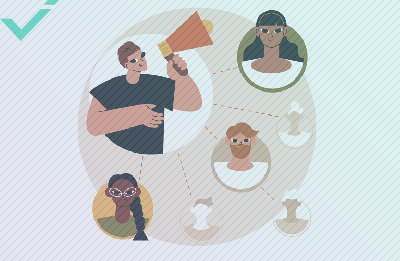Should you use images in blog posts in 2018? It might seem that “no” would be the most logical answer. After all, many people surf the web from mobile devices these days. Recent statistics show that the percentage of visits from mobile devices grew from 57% in 2016 to 63% in 2017.

Source: stonetemple.com
Upon realising this, some may be quick to write off the necessity for images, as they do tend to affect the download speed of the page and sometimes the entire format of the post. However, despite these potentialities, you absolutely should use images in your posts if you want to boost views and shares.
WHY SHOULD YOU USE IMAGES IN YOUR BLOG POSTS?
1: IMAGES CATCH ATTENTION QUICKLY
People are visual creatures. A large percentage of our brain is dedicated to visual processing. Furthermore, we recognise a familiar object within 100 milliseconds. Knowing that we respond to images before anything else on a page, visual content can be a great way to capture an audience’s attention with what otherwise may have been a more “boring” post. Vivid, well-chosen imagery can completely change the way a piece of content is received, so why skip out on an extra opportunity to engage your audience?

2: IMAGES GET MORE SHARES
A study conducted in 2015 showed that articles containing images received 94% more views than ones without images at all. This works not only for websites and blogs, but for social media as well. The same study showed that Tweets with images were retweeted 150% more compared to text-only ones. Another study conducted in 2017 proved that Facebook posts with images receive three times more engagements than posts without. Therefore, it’s safe to assume that images are a simple yet effective way to boost shares.
3: IMAGES BOOST SEO
Proper image optimisation is a way to effectively boost your SEO. For instance, adding ALT tags to images can help the audience understand context better; like when an image isn’t displayed properly due to slow internet connection. However, this also allows Google Search crawlers to understand the context of the page better, which could improve rankings as well. Of course, in order to achieve that, you need to make the ALT tags as specific as you can.
4: IMAGES INCREASE ARTICLE LENGTH
Of course, longer doesn’t mean better. However, when a person sees an article with images and backlinks, they automatically start taking it more seriously. This is especially important when it comes to shorter posts that tend to look less detailed and valuable. If you add a couple of images to them, you’ll make the post look more impressive without messing with the context.
5: IMAGES HELP TO VISUALISE
Visualisation is critical when it comes to tutorials. Sometimes it’s nearly impossible to understand the content of a tutorial post without proper visuals. But even when visualisation isn’t crucial, it could still add some value to your article. People like when they can see the things you’re writing about. Furthermore, they are able to remember these things better after they visualise it. Now that you see just how crucial images are to online success, let’s move on to how to add great images to your blog posts without violating copyright.

WHERE TO FIND GREAT IMAGES FOR BLOG POSTS
If you can create compelling images for yourself, that’s great! If not, however, you need to know where to look for them. It’s paramount to respect copyright while doing so, therefore your options might seem limited at first. However, it’s not that bad at all.
IMAGE STOCKS
Unsplash is a stock where you can find beautiful images free for both commercial and non-commercial use. Pixabay is great too, though there are both free and paid images on this site. You can settle with these two, or you can look for more. There are plenty of great image stocks available online, but you need to keep in mind that their terms of use might differ a lot. Some of them are paid-only, some offer an impressive collection of free images, and some offer only a couple of them for free. Always check the rules to make sure you don’t get yourself in trouble after sharing a certain image on your website.
Googling images might be the first option that comes to mind. However, you must use it wisely to avoid trouble. Google provides detailed instructions on how to find free-to-use images with its help, so be sure to check it out before you start your search. In short, you can sort the images in Google Search by their usage rights, filtering the ones that best suit you.

Source: deakincopyright
CANVA
Canva is an online graphic editor that can be used even by those who have no previous experience with tools like Adobe Photoshop or Sketch. While it isn’t the easiest option out there, it can be a great one for those looking to find the perfect image for their content. Canva has a huge collection of premade designs, including drawings, quotes, and much more. You can select some of them and adjust to your needs, therefore creating original pieces that you can add to blog posts. As you can see, even when you have little time and limited resources, you can still come up with vivid and appealing images for your blog. Try it out and see if it makes a difference for your website!


